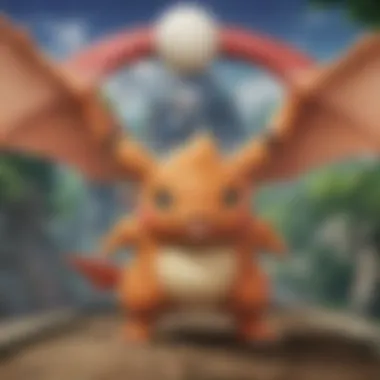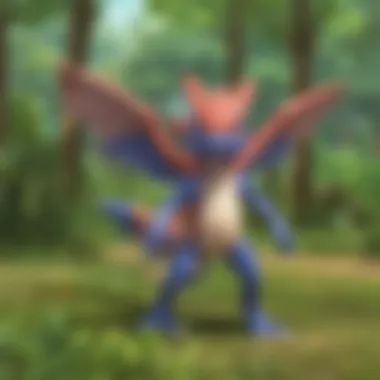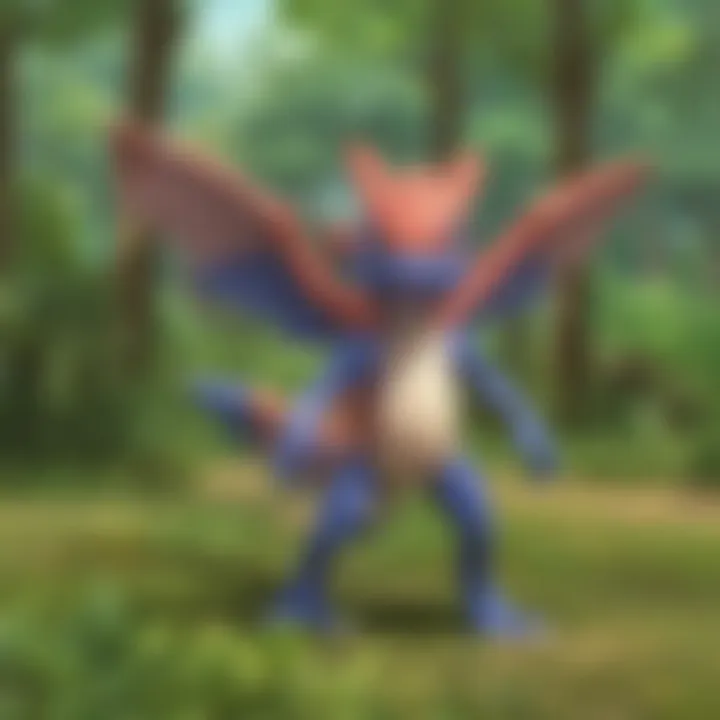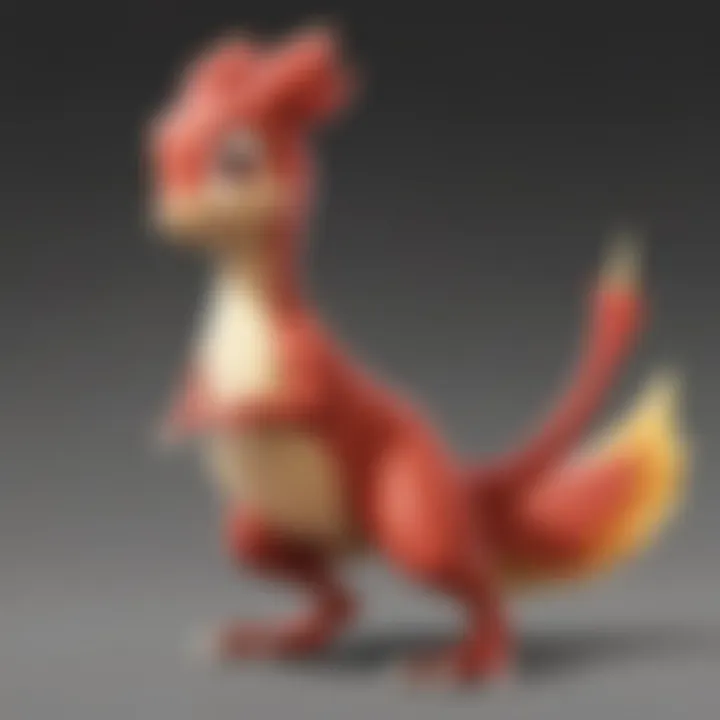A Complete Guide to Pokemon Y on 3DS


Intro
In the expansive world of video games, few franchises have captured the hearts of fans quite like Pokemon. Launched in the mid-90s, it laid roots in the gaming culture that continues to thrive even today. Each new title carries not just the legacy of its predecessors but also a freshness that attracts both newbies and veterans alike. One such entry is Pokemon Y, tailored for the Nintendo 3DS. This game has opened up a plethora of avenues for players to explore.
With its vibrant visuals, intricate gameplay mechanics, and beautifully crafted characters, Pokemon Y stands as a hallmark in the franchise. From the moment players pop their cartridges into their handheld consoles, they embark on a journey filled with adventure, friendship, and strategic battles. This guide aims to peel back the layers of Pokemon Y, offering players insights into its gameplay mechanics, character dynamics, and advanced strategies that can transform a standard playthrough into a deeply rewarding experience.
Preface to Pokemon Y
In the vast universe of Pokémon, Pokemon Y stands out not only for its unique features but also for its strategic gameplay elements. This installment introduces players to the beautiful Kalos region and a fresh set of Pokémon that enhance the franchise's traditional catch-and-battle mechanics. For both newcomers and seasoned trainers, understanding Pokemon Y is crucial, as it serves as a gateway to experiencing some of the most accomplished aspects of the Pokémon series.
Overview of the Pokemon Series
Since the release of the first games in the late '90s, the Pokémon series has captivated audiences worldwide. With every generation, the games have evolved, introducing new Pokémon, regions, and mechanics. The heart of the series lies in collection, strategy, and battle, allowing players to engage in a diverse ecosystem of creatures.
In Pokemon Y, the game embraces this heritage with fresh ideas while respecting the legacy. The narrative captures themes like friendship, adventure, and rivalry, which are timeless elements appealing to fans of all ages. This installment reinforces the notion that Pokémon is not just about battling; it's about forming connections, experiencing growth, and unraveling a story.
Understanding the 3DS Platform
The Nintendo 3DS, launched in 2011, was a significant advancement in handheld gaming technology. The device introduced stereoscopic 3D graphics without the need for special glasses, significantly enhancing the visual experience. For Pokemon Y, this means engaging in battles with dynamic visuals and exploring 3D-rendered environments, creating a more immersive experience.
Each corner of the Kalos region, from bustling cities like Lumiose to the serene routes that wind through forests, is brought to life in rich detail. The 3DS also supports augmented reality features and street pass interactions, adding layers of interactivity. Players can battle or trade with others nearby, making the tactile experience of Pokémon even more social.
Therefore, as players embark on their journey through Pokemon Y, appreciating the significance of the 3DS platform provides context to the game's innovations. The blend of cutting-edge technology and beloved gameplay mechanics forms a compelling foundation for what many consider one of the best entries in the Pokémon saga.
Key Features of Pokemon Y
The introduction of Pokémon Y brought a flurry of fresh concepts and modifications that injected new life into the franchise. With so many unique features on offer, understanding their significance enhances gameplay and enriches the player experience. Whether you are a newcomer or an experienced trainer, these key features provide essential tools and strategies for embarking on your journey through the Kalos region.
New Mega Evolutions
One of the most notable advancements in Pokémon Y is the feature of Mega Evolutions. This mechanic allows certain Pokémon to evolve into far stronger variants temporarily during battles. What sets this apart is not just the enhanced stats but also the reimagined designs and typings for some Pokémon, which can truly turn the tide in a challenging battle.
For instance, Mega Charizard X transforms from a Fire/Flying type to a Fire/Dragon type, gaining significant advantages against many opponents. This type shift can catch opponents off guard, allowing for some unexpected strategies. The process works by using a Mega Stone, which each Pokémon requires to undergo this transformation. Trainers have to carefully consider when and how to use Mega Evolutions, as each Pokémon can only Mega Evolve once per battle.
"Mega Evolutions signify the turning point of strategy in Pokémon battles, adding layers of complexity that can only be mastered through experience."
Pokémon Amie
Pokémon Amie is another fantastic feature that encourages a deeper bond between trainers and their Pokémon. Simply put, it’s like having a little mini-game where players can interact with their Pokémon directly. By petting, feeding, and playing with them, trainers can influence their Pokémon’s performance in battles.
The quality of interaction is visually indicated through affection levels, which can lead to benefits such as improved evasiveness during fights and enhanced critical hit chances. This system fosters an emotional connection with one’s team and can be particularly appealing for those who appreciate the relationship aspect in gaming. The time spent in Pokémon Amie isn't just fluff; it’s strategically helpful too.
Diversity of Pokémon Types
The beauty of Pokémon Y lies in the extensive diversity of Pokémon types present within the game. Players encounter various types that allow for unique strategies in battles, specifically designed with synergy and counter-play in mind. With over 70 new Pokémon introduced, trainers have ample opportunity to mix and match types to find a combination that suits their battle style.
Understanding type advantages can mean the difference between victory and defeat in crucial battles. Some may gravitate towards the Fairy type for its resistance against Dark and Dragon types, while others might prefer the robust reach offered by Steel types. Engaging in battles often necessitates knowledge of these types, which encourages players to fully explore the roster.
Additionally, with the addition of new type combinations and evolutions, trainers have the chance to discover intriguing matchups, continually evolving their approach as the game progresses.
Game Mechanics Explored
Understanding the game mechanics in Pokémon Y is vital for players looking to maximize their gameplay experience. These mechanics not only dictate how battles unfold but also influence the journey of capturing Pokémon and leveling them up. Mastering these mechanics can offer noticeable advantages whether you are battling friends, competing online, or exploring the vast world of Kalos. This section will unfold the intricacies behind the battle system, catching methods, and the experience point dynamics that shape the rhythm of Pokémon Y.
Battle System Enhancements
The battle system in Pokémon Y introduces several enhancements that make encounters more dynamic compared to its predecessors. One of the most notable updates is the concept of Mega Evolution. This allows certain Pokémon to temporarily evolve during battle, significantly boosting their stats and sometimes changing their abilities. For example, a Charizard can Mega Evolve into Mega Charizard X or Y, bringing unique advantages depending on the situation. This introduces an element of strategy not seen in earlier titles, pushing trainers to carefully consider when to utilize this feature.
Furthermore, the Fairy type was added, which changes the combat landscape. Fairy types prove effective against Dragon types—a much-needed counterbalance within the Pokémon ecosystem. As players delve into battles, understanding type advantages is essential. Leveraging the strengths and weaknesses can turn a tide in battle.
Visual enhancements also play a role. The 3D graphics on the Nintendo 3DS not only make battles visually pleasing but also add depth to the gameplay. Each action during combat feels more immersive, increasing the stakes of every move made.
Overall, these enhancements require trainers to think on their feet and adapt strategies as the battle unfolds. Game mechanics in Pokémon Y provide a fresh feel, ensuring that even seasoned players find something new to chew on.
Catch Mechanics
Catching Pokémon in Y involves more than just throwing Poké Balls and hoping for the best. There’s a bit of nuance that adds depth and excitement to this classic gameplay element. The introduction of Poké Finder adds a new layer to catching Pokémon. Players can utilize this feature to take snapshots of Pokémon in their natural habitats. This enhances interaction and allows trainers to observe behaviors before attempting to catch them.


Consider the type of Poké Ball used; different balls provide varying rates of success based on specific factors. For example:
- Ultra Balls: Higher catch rate than standard Poké Balls, effective in tougher captures.
- Great Balls: A middle ground for harder to catch Pokémon, useful before Ultra Balls.
- Timer Balls: More effective the longer the battle, a clever choice for extended encounters.
Moreover, the new horde encounters mechanic introduces multiple Pokémon appearing at once. This has the potential for more dynamic catches, but also demands split-second decision-making from the trainer. Players might find a rare Pokémon hiding within a horde, but they have to act swiftly to avoid fainting their target.
All in all, the catch mechanics in Pokémon Y enrich the experience, pushing trainers to think creatively about how to approach every potential catch.
Experience Point System
The experience point system in Pokémon Y has been refined, impacting how players develop their teams. Gone are the days where grinding was a necessity—now, players can gain experience in more varied and engaging ways. Regular battles do award experience points, but completing tasks, defeating trainers, and even participating in mini-games contribute to leveling up Pokémon.
Utilizing the Exp. Share item allows all Pokémon in a trainer’s party to gain experience, even when they aren't directly participating in battles. This is a game-changer for players looking to build a balanced team without the extensive grind that may have characterized previous titles. Additionally, the more time a Pokémon spends in battle, the better they become at understanding strategies and improving their performance.
The experience point system provides a more seamless way to train Pokémon, allowing players to explore various regions without pocketing all their time just grinding for levels.
In summary, understanding the intricacies of the experience point system allows trainers to optimize their battle sessions and enhance their team efficiently, catering to a more enjoyable experience in Kalos.
The Kalos Region: A Detailed Overview
The Kalos region serves as a vibrant backdrop in Pokemon Y, adding depth to the gameplay experience. This region is not just a map where players traverse; it embodies the essence of the game's themes, influencing how trainers interact with their Pokémon and the world around them. Understanding Kalos goes beyond geography; it’s about grasping the cultural, emotional, and narrative nuances that shape a trainer's adventure. Players will appreciate how this unique environment fosters not just competition among trainers but also promotes a bond with the Pokémon they catch.
Geography of Kalos
Kalos is distinctively modeled after northern France, featuring diverse landscapes that range from bustling cities to serene countryside. The geography impacts gameplay significantly, providing various terrains that cater to specific types of Pokémon. From the lush forests of Santalune to the rocky paths leading to Victory Road, the land itself suggests different strategies and approaches for battling and capturing Pokémon.
- Major Areas: Each area of Kalos, such as Lumiose City with its skyscrapers or Route 4 with its winding paths, is designed to guide players in exploring not just Pokémon but the environment itself.
- Regional Diversity: The combination of urban and rural settings allows players to experience the charm of Kalos, encouraging exploration that is pivotal to gameplay. Trainers will find themselves strategizing not just against other trainers, but against the very nature of the land.
Landmarks and Cities
Kalos is peppered with iconic landmarks and cities that are more than just resting spots for trainers; they are central to the game's narrative and world-building.
- Lumiose City: The hub of Kalos and an architectural marvel, it serves not only as a shopping destination but also as a center for battling, a perfect setting for trainers to clash.
- Céladon City: Known for its vast Pokémon Center and shops, Céladon is where trainers can stock up on useful items before tackling the challenges that lie ahead.
"Navigating through Kalos feels like unraveling a tapestry, where each thread leads to a new adventure."
Players are encouraged to take their time exploring these cities, as they often hold stories and quests that provide more than just material rewards.
Cultural References
Kalos isn't just a geographical space; it embodies cultural traits that resonate with players and reflect real-world influences, enriching the Pokémon experience.
- Artistic Influence: From the architecture to the Pokémon designs, many aspects are inspired by French art and culture, culminating in a game that feels both familiar and fresh.
- Fashion and Style: The emphasis on trainers' appearances and the inclusion of fashion features represent a nod to the strong fashion industry in the real-world region of France; trainers can truly express themselves, adding a personal touch to the journey.
Kalos invites players to immerse themselves in its culture, revealing layers of meaning that enhance both gameplay and emotional connection to the world of Pokémon.
Building Your Team
Creating a strong Pokémon team is a key element in finding success in Pokémon Y. The diverse array of Pokémon available in the game, each with unique abilities and traits, reflects the importance of thoughtful team composition. A well-constructed team allows players to tackle various challenges throughout their journey in the Kalos region, making gameplay smoother and more enjoyable. Assembling a balanced team equipped to handle a variety of situations can significantly impact your in-game experiences, from gym battles to elite encounters.
Selecting Optimal Pokémon
When it comes to selecting the best Pokémon for your lineup, context is everything. Each player has their own preferences, but a critical component is understanding your options thoroughly. Not all Pokémon are created equal; their stats, type advantages, and moves dictate their effectiveness in various situations.
For example, choosing a fire-type Pokémon like Chesnaught, evolving from Chespin, can provide a significant edge against grass-types and bug-types. On the other hand, pairing it with a water-type Pokémon, such as Frogadier, helps create a synergy that broadens your team's coverage. These synergies are often critical when facing diverse opponents.
Consider factors like:
- Stats: Pay attention to Attack, Defense, and Speed.
- Type Coverage: Aim for a mix of types to handle various challengers.
- Moveset Variety: Incorporating both offensive and defensive moves offers more options during battles.
Types and Matchups
Understanding Pokémon types and their matchups is fundamental. The type system is a bit like rock-paper-scissors, where certain types have advantages over others. For example, electric-type moves are super effective against water-types but weak against ground-types. Knowing these interactions can make or break a battle.
It helps to think strategically about how each Pokémon complements the others within your team:
- Using Pokémon with type advantages increases your chances in gym battles.
- Conversely, having a diverse types ensures you’re not left vulnerable to specific Pokémon types.


A balanced approach consists of recognizing not just the strengths but also covering your weaknesses. If your primary Pokémon are weak against ground attacks, for instance, it would be wise to include a flying-type, like Pidgeot, for support.
Balanced Team Composition
Achieving balance in your team can lead to a comprehensive strategy that can adapt to multiple challenges. Focus on these aspects when composing your team:
- Tanky Pokémon: These are high in Defense and HP, which can absorb damage. Pokémon like Gardevoir are often excellent choices thanks to their versatility.
- Attackers: Whether physical or special, having a couple of strong attackers is crucial. Pokémon like Lucario or Gyarados can deal impressive damage.
- Support Pokémon: Don't overlook the utilities that support Pokémon can provide. Moves like Light Screen or Reflect can drastically affect the course of battle, covering team weaknesses.
Harboring a mixture of these elements promotes resiliency, allowing you to pivot in battles depending on the current situation. A balanced team isn’t just about flaunting rare Pokémon; it’s about foresight, knowing that versatility and adaptability are your best allies in the Kalos region.
Assembling a team is a marathon, not a sprint. Take time to consider your options and adjust your strategy based on your ongoing experiences.
In-Game Events and Quests
In the world of Pokémon Y, in-game events and quests serve as a gateway into a deeper gameplay experience. They add layers of excitement, allowing players to go beyond the main storyline and dive into various challenges and rewards. The significance of these pursuits lies not only in the battles they entail but also in the unique narratives and character interactions they introduce, enriching the overall adventure.
Gym Battles
One of the marquee aspects of Pokémon Y's in-game events is the Gym Battles. These are not merely about winning; they are about strategy, location, and, most importantly, your chosen Pokémon’s type. Each of the eight Gym Leaders in Kalos has their own theme and specialty. Understanding their strengths and weaknesses is crucial. For instance, the first Gym Leader, Viola, focuses on Bug-type Pokémon. Bringing a Fire or Flying-type will give players a significant advantage.
Players should come prepared. It's wise to stock up on potions and revives since they can be a lifesaver mid-battle. The battles themselves often feel like mini-events filled with tension, showcasing the player’s development and their connection with their Pokémon. Proving your mettle here is not just about becoming a Champion; it’s about refining your skills and pushing your strategic thinking.
Legendary Pokémon Encounters
Encounters with legendary Pokémon are another highlight of the in-game experience. These events aren't just typical encounters; they are epic trials. Each legendary Pokémon, like Yveltal or Zygarde, has its unique lore and skill set. The thrill is in the hunt and in devising a tactical approach.
When a player finally gets to face one of these legendary beings, it's imperative to have the right arsenal. Stocking up on ultra balls and status-inducing moves can make a world of difference. Besides, legendary Pokémon often appear during specific events, making their encounters feel special and purposeful. Players often share their strategies on forums like reddit.com, discussing the best methods for capturing these elusive creatures.
"Patience and persistence are your best tools in the hunt for legendary Pokémon. Don’t rush; every moment counts."
Side Quests and Story Elements
Side quests in Pokémon Y can feel like hidden gems scattered throughout the Kalos region. Unlike Gym battles or legendary encounters, these quests often touch on character development, local folklore, or even humorous stories that lend depth to the environment. For example, players might assist the residents of Lumiose City in fetching lost items or battling rogue trainers.
Completing these side quests not only yields rewards, like unique items or experience points, but they also shed light on the lore of the Pokémon world. Moreover, they encourage exploration and learning about the region you are immersed in. The connections made through these smaller stories can resonate equally, if not more, than the primary storyline.
Understanding Competitive Play
In the world of Pokémon, competitive play offers a thrilling layer beyond casual encounters. It's where strategy meets skill, and every choice counts. When approaching Pokémon Y, it's crucial to grasp the nuances of the competitive scene. Not only does it enhance your gameplay, but it also deepens your appreciation of Pokémon as a dynamic ecosystem, full of unique strengths and weaknesses.
Overview of Competitive Formats
Competitive play in Pokémon Y can take various shapes and sizes. Some of the main formats include:
- Singles: This is the classic format where each player has a team of six Pokémon, but only one is active at a time. Strategy here revolves around predicting your opponent's moves and counters.
- Doubles: Two Pokémon per side make this format more complex. Coordinating moves to create combos is key, as one Pokémon's action can affect the other on the same side.
- Battle Royale: A unique twist, this format features four trainers battling simultaneously. Here, alliances may shift, and unpredictability reigns supreme.
Understanding these formats helps in building your team effectively and preparing for the unexpected during battles.
Team Strategies
When it comes to competitive play, having a solid strategy is essential. Here are some key strategies that can tilt the odds in your favor:
- Diversity: Don’t put all your eggs in one basket. A well-rounded team featuring various types ensures that you’re covered against different threats. For example, pairing water types with electric types can mitigate weaknesses.
- Role Distribution: Each Pokémon on your team should serve a purpose. Consider having:
- Synergy building: Some Pokémon perform better when paired with others. For example, a Pokémon with moves that cause status effects can work well with another that exploits those effects.
- Adaptability: The competitive scene is fluid. Be prepared to alter your strategies based on the specific opponents you face. Flexibility is critical for success.
- A tank that can absorb damage.
- An attacker to deal heavy hits.
- A support Pokémon that can heal or enhance abilities.
Common Pitfalls in Competitive Play
Despite the excitement of competitive battles, players often stumble into predictable traps. Here are some common missteps:
- Over-relying on one Pokémon: Many trainers might pin their hopes on a single powerhouse, but this can lead to swift defeat if that Pokémon is countered effectively.
- Ignoring type matchups: It sounds elementary, but forgetting to consider types can be fatal. Familiarity with type advantages and disadvantages should be second nature.
- Neglecting speed tiers: A common oversight is the failure to account for which Pokémon will act first. Speed can often determine the outcome of key moments in battle.
"Victory is often decided before the battle begins. Preparation is half the battle." – An old adage in the Pokémon competitive community.
Making an effort to learn these elements will not only boost your competitive edge but will also enrich your overall experience in Pokémon Y. The blend of strategy, preparation, and adaptability is what makes the competitive scene so compelling.
Advanced Strategies


When it comes to maximizing your experience in Pokemon Y, understanding advanced strategies can truly take your gameplay to the next level. The topic is not just a cherry on the cake; it’s the foundation of building a formidable team that can tackle the most challenging battles the game throws at you. This section will delve into essential techniques such as effective training methods, the importance of time management during battles, and how to utilize TMs and HMs to your advantage. These strategies are crucial for both honing your skills as a player and achieving a deeper understanding of the made complex gameplay.
Training Techniques
Training your Pokemon is akin to honing a craft; it requires focus, intent, and sometimes a touch of finesse. The goal is not just to level up but to cultivate a team that can withstand the heat of intense battles. Here are some techniques to consider:
- Utilizing Exp Share: This item is invaluable in ensuring that all your Pokemon gain experience, especially those who may not see much battle time. It essentially distributes the experience points among your team, facilitating a consistent leveling.
- Participating in Battles with Strong Trainers: Seek out trainers with higher levels, as defeating them will yield more experience. In-game locations like the Battle Chateau can yield notable rewards.
- Friendship Evolutions: Some Pokemon evolve based on friendship levels. Use items like the Soothe Bell, which boosts friendship while carried, to facilitate these evolutions.
Remember, it’s a marathon, not a sprint. Balancing training sessions with actual battles can give you that edge over opponents who might just focus on sheer level and power alone.
Time Management in Battles
Time management may not seem like a traditional concept within the realm of Pokemon battles, yet it bears immense significance. A well-timed strategy can make or break a match. Here’s how to hone your skills:
- Know Your Opponent: Take a few moments to assess the types your opponent is using before making a decision. Each second counts, and understanding your foe can provide a critical insight into the most favorable moves.
- Anticipate Moves: Practice anticipating opponents’ moves based on their previous actions. Certain trainers have predictable patterns. Leverage this knowledge to plan counter-strategies effectively.
- Speed and Priority Moves: Understand how speed affects battle order. Use priority moves when you’re feeling pressured; they can give you that edge in tight situations, especially when facing faster opponents.
"Mastering the art of timing in battles allows you to not only improve your winning potential but also enhances your overall enjoyment of the game."
Utilizing TMs and HMs Effectively
Teaching your Pokemon new moves through TMs (Technical Machines) and HMs (Hidden Machines) can often be the trump card in battles. Here’s how to make the most of these tools:
- Tailor Movesets to Your Strategy: Always choose TM moves that complement your team's strengths and cover weaknesses. For instance, if your Pokemon is strong defensively, consider moves that can wear down opponents over time.
- Plan Your HMs Wisely: HMs, unlike TMs, can’t be unlearned easily. Thus, use them for utility Pokemon—those that may not be in your primary battle roster. Utilize Pokemon with moves like Surf or Fly for navigation to enhance your gameplay experience.
- Experiment and Adapt: Don’t hesitate to switch moves depending on the situation at hand. You might discover that certain combos work better against specific opponents.
In the end, mastering advanced strategies isn’t about memorization. It’s about understanding the flow of the game, being adaptable, and spending time to refine your techniques while keeping things fresh and insightful for your Pokemon journey.
The Evolution of Pokémon Games
The Pokémon series has undergone a remarkable transformation since its inception in the late 1990s. Each new installment has brought in innovative mechanics, captivating storylines, and diverse Pokémon species, keeping the franchise fresh and engaging for fans. In this section, we will explore the significance of this evolution in detail. It’s important not only for understanding Pokémon Y but also for appreciating how far the series has come.
Historical Context
The journey of Pokémon began with Pokémon Red and Green—released in Japan in 1996. These games introduced players to a vibrant world teeming with memorable pocket monsters. From there, the concept took off like a rocket. Each generation brought with it various enhancements: new gameplay mechanics, expanded Pokémon rosters, and richer storytelling. For instance, the introduction of Pokémon Gold and Silver added two regions to explore and allowed players to revisit the Kanto region after finishing Johto. This was a significant leap, as it doubled the content and added depth to the journey.
The implementation of features like breeding, the day-night cycle, and new types elevated the gameplay experience. As we moved into the 3D era with Pokémon X and Y, the series embraced fully polygonal graphics and improved online connectivity, creating a fundamentally different experience that we hadn't seen before. These historical milestones have set the stage for an ever-evolving narrative and gameplay experience.
Transition to 3DS and Its Impact
With the launch of the Nintendo 3DS, players experienced a new dimension—a literal one, as 3D graphics became the norm. Pokémon Y was a headliner for this platform, showcasing its capabilities. The shift to 3DS allowed for a more immersive experience and introduced features like StreetPass and enhanced online battling. Moreover, the graphics and animations received a near-complete overhaul, making Pokémon feel more alive than ever.
Players found that they could now see their Pokémon's expressions and movements in striking detail. Battles became more dynamic, couplings of Mega Evolutions brought fresh strategic options, and the world felt more engaging with its stunning visual design.
With this leap into 3D, not only did the aesthetics improve, but so did the mechanics. Players could navigate a truly three-dimensional world, leading to more complex strategies and interactions.
Future Directions in Pokémon Gameplay
Looking ahead, the possibilities for the Pokémon franchise seem boundless. Based on patterns and consumer feedback, we can anticipate further innovations that enhance gameplay experience. These could include greater integration of augmented reality, which could expand the boundaries of how players interact with the Pokémon universe. The combination of real-world locations and Pokémon encounters can take immersion to a whole new level.
Moreover, the trend towards online multiplayer features may likely grow. With Pokémon aiming to foster community through battling and trading, future iterations might expand the social elements even more. Incorporating ecosystems where players can participate in regional events or community raids could prove invaluable.
In summary, the evolution of Pokémon games not only showcases the past successes but also hints at exciting futures. By understanding these changes, players can better appreciate both Pokémon Y and the franchise as a whole.
"The appeal of Pokémon lies in its ability to adapt and inspire, inviting players to explore new possibilities in each generation."
As the franchise continues to grow, it remains crucial for players—both new and seasoned—to stay attuned to these developments for continued enjoyment and strategic engagement.
Epilogue
The conclusion serves as a critical capstone to our exploration of Pokemon Y for the Nintendo 3DS. It encapsulates the multifaceted discussions we've had throughout the guide and underscores the significance of the game within the larger Pokemon franchise. This title is not just a mere extension of its predecessors but rather a transformative leap, introducing concepts such as Mega Evolutions and Pokémon Amie that deepen player engagement and satisfaction.
Recap of Key Insights
Throughout this guide, we've traversed various dimensions of Pokemon Y, highlighting key features and systems that define its gameplay style. We've discussed how new gameplay mechanics enhance the battle experience, creating dynamic encounters that challenge both novices and veterans alike. The integration of the Kalos region's diverse geographical and cultural settings adds a rich backdrop against which players can build their Pokémon journeys. Here are some of the pivotal points we've covered:
- Mega Evolutions: Revolutionizing strategies in battles, offering new depths to team customization.
- Pokémon Amie: Fostering greater bonds between player and Pokémon, enhancing the overall experience.
- Team Building Strategies: The importance of understanding types and matchups for competitive success.
- Engaging Quests: The myriad of in-game events and legendary encounters that keep players invested.
By weaving these elements together, Pokemon Y cements its position as a cornerstone in the series and attracts both long-standing fans and new players alike.
Encouragement for Exploration
As we conclude, it’s worth reiterating the call to adventure that Pokemon Y embodies. Players are gently nudged to explore the stunning Kalos region, engage with its vibrant culture, and immerse themselves in the unique challenges presented. The core of any Pokémon game lies not just in battling but in exploration, discovery, and the personal connections you create along the way.
- Seek Hidden Items: The world is full of surprises, hidden items, and encounters waiting for the discerning player to uncover.
- Engage with NPCs: Characters throughout Kalos offer quests and dialogues that enhance the narrative experience.
- Experiment with Team Compositions: There’s no one-size-fits-all solution; find what works for you and adapt; flexibility is key.
In essence, Pokemon Y offers a rich tapestry of experiences ready for players to dive into, pushing the boundaries of what they know about Pokémon games. As you venture forth, remember that with every step, there are countless tales to uncover and friendships to forge in the ever-expanding Pokémon universe. A true adventure awaits!







